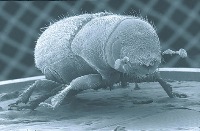Party animals

The mountain pine beetle. Leslie Manning Natural Resources Canada
23 June 2008
Party animals
Predicting the spread of the mountain pine beetle, which is devastating the lodgepole pine forests of British Columbia, is like watching guests at a party according to an Aberystwyth academic.
Dr Javier Gamarra, a lecturer in Environmental Systems at Aberystwyth University, has been studying the spatial patterns of beetle attacks from records covering a 37 year period. He has developed a mathematical model that predicts the extent and locality of future forest damage based on damage caused by the beetle in previous mild winters.
Dr Gamarra's findings feature in the July edition of the British Ecological Society's Journal of Animal Ecology published on Monday 23 June. An electronic version of the paper ‘Spatial scaling of mountain pine beetle infestations' is available at http://www.blackwell-synergy.com/doi/full/10.1111/j.1365-2656.2008.01389.x.
A series of mild winters during which minimum temperatures have remained above -40oC has resulted in higher larval survival rates and an explosion in the beetle population in British Columbia. Adult females attack the lodgepole pines by boring through the bark in order to deposit their eggs. The resulting larvae feed on the tree causing it to die within weeks.
Natural Resources Canada and the Canadian Forest Service predict that carbon dioxide released by rotting lodgepole pine trees could result in western Canada moving from a net carbon sink to become a net contributor of carbon to the environment by 2020.
Dr Gamarra draws an analogy between the way the beetle spreads out in the forest and the behaviour of guests arriving at a party to illustrate his model.
“By observing people as they arrive at the party, you will find that the early arrivals will group together. As more and more arrive they form groups, the more guests the greater the size difference between the largest and smallest groups. If you happen to be a shy, cold and lonely soul your chances of ending up in a corner with your drink as your only companion increase as the party grows. However being the warm, popular guy, your ego will be rewarded the more people come in.”
“Interestingly the mountain pine beetles develop the same patterns when they feast on lodgepole pines in British Columbia. A cold winter will reduce the number of larvae that survive and the number of beetles that reach maturity (a small party). A milder winter will increase larvae survival rates and consequently the numbers of beetles (a big party). This leads to a much wider geographical spread with the extent of damage varying from area to area with some showing little damage (colder regions = lonely soul) and others more.”
“Warmer areas such as deeper valleys (warmer regions = popular guy) will attract more beetles and suffer more damage. As the beetle population increases the model enables us to predict how they will spread out geographically and the difference between group sizes and spatial heterogeneity.”
Dr. Gamarra is now trying to expand this "party hypothesis" to other pests. "Preliminary analyses point to other pests exhibiting the same pattern of behaviour, like the desert locust in the Sahara. The bad news is that climate change will produce increasingly mild winters, reducing larval mortality and raising the risk of damage to many forests and crops", he added.
Dr Gamarra is a lecturer in Environment Systems at IBERS, the Institute of Biological, Environmental and Rural Sciences (http://www.aber.ac.uk/en/ibers/) at Aberystwyth University, and is funded by CIRRE, the Centre for Integrated Research in the Rural Environment (www.cirre.ac.uk), a research partnership between Aberystwyth and Bangor universities.
His work, in collaboration with F. He at the University of Alberta, has been supported by the Mountain Pine Beetle Initiative of Natural Resources Canada / Canadian Forest Service.



